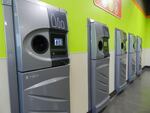For the first time since Oregon’s Bottle Bill recycling program began, Oregonians returned more than two billion beverage containers, as the program paid out more than $205 million to consumers and local nonprofits in 2022.
The Oregon Beverage and Recycling Cooperative, which oversees the Bottle Bill program, recently released its 2022 data.
According to OBRC president and CEO Jules Bailey, the program hit another milestone — the highest redemption rate in the nation. On average Bailey said the redemption rate across the nation is 35%.

A row of sparkling clean reverse vending machines greet customers at the grand opening of the Medford BottleDrop center.
Jes Burns/EarthFix
“We had last year, the highest redemption rate in the nation and this year we’ve even gone up from that redemption rate,” he said. “We went from 80.6% up to 88.5%.”
Oregon’s Bottle Bill is a first-of-its-kind recycling program that was implemented in 1971 to reduce a growing litter problem along Oregon beaches, highways and other public areas. It’s funded by implementing fees on distributors depending on the bottle and container sold in stores.
The redemption program charges a 10-cent fee when consumers buy a redeemable container which they can get back when they return the empty container to redemption centers or participating stores.
Consumers can open BottleDrop accounts and choose to keep the funds or defer their redemptions to benefit nonprofits and programs like food banks, schools and environmental groups. In 2022, more than 5,000 Oregon nonprofits raised $5.1 million by redeeming bottles and cans.
One of those is the Oregon College Saving Plan. After launching more than three years ago, the program recently announced it reached $1 million saved for higher education through the Bottle Bill program.
“It’s hard to imagine a million bucks adding up a dime at a time, but it did,” Bailey said.
He said there are three reasons why the program has been so successful: convenience, incentives and “the goodwill and the environmental ethic of Oregonians.”
“Oregon offers a lot of incentive to return bottles and cans,” he said. “We offer a lot of different ways to get your money back.”
Besides the financial incentive, Bailey said most of the recycling happens locally and gets put right back in the state.
“It’s very closed loop, and that’s one of the benefits of having a deposit return system,” he said. “It stays mostly here in Oregon or at least in the United States and gets turned right back into the bottles and cans that people are using.”
According to the OBRC report, the returns from 2022 removed more than 50,000 metric tons of carbon dioxide, a byproduct of fossil fuel that contributes to climate change, by recycling containers rather than sending them to a landfill. That’s the equivalent of removing more than 11,000 passenger cars from the roads, according to an Environmental Protection Agency greenhouse emissions calculator.
Since its inception, the program has gone through many updates including water-flavored containers, juices, teas and other noncarbonated beverage containers. Bailey said in 2025, wine cans will be added to that list.
“What’s really next for the deposit system and for BottleDrop is continuing to open more locations, continuing to expand access and then also continuing to make it easier for customers and more transparent,” he said.
Bailey said during the pandemic, BottleDrop redemption centers remained open but some participating stores did suspend the program. He said because of that, redemption rates dropped but still remained around 80%.
Right now, there are 94 drop locations across the state. Bailey said by June the program will have 100 locations open and plan to expand its coverage in The Dalles, Prineville and Ashland.
